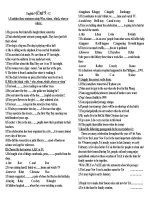Unit 6Skills1
Bạn đang xem bản rút gọn của tài liệu. Xem và tải ngay bản đầy đủ của tài liệu tại đây (559.03 KB, 8 trang )
<span class='text_page_counter'>(1)</span>Teacher: Huynh Phong Dinh.
<span class='text_page_counter'>(2)</span> 1. Work in pairs to answer the following questions.. 1. What are the things in the pictures? The first picture shows an old tram. The second picture shows a modern train. -_____________________________ 2. When and where can you see them? The tram would have been seen in a town or city. These trains can be seen -_____________________________ nowadays in big, modern cities. 3. How different are they? + the first -_____________________________ has fewer compartments (two or three) than the second (four). + the first runs much more slowly. + the first is not air-conditioned while the second is. + the first runs along tracks on the ground at street level, while the second runs on elevated tracks. + the first is powered by overhead electricity wires, while the second runs on electromagnetics..
<span class='text_page_counter'>(3)</span> 2. Now read the article from a travel magazine. THE TRAM SYSTEM IN HA NOI: THEN AND NOW. Ha Noi had its first tramways in 1900. The tram system was a major means of transport in the city for nine decades and thus the image of the tram and its clanging sounds have gone deep into the hearts and minds of Hanoians. Since it was convenient and cheap to get around the city and to the suburban areas by tram, the system was very popular. However, due to the population boom and the need for a wider road system, the last rail track was removed. . Now, after more than 20 years, the population of Ha Noi has risen from about two million people to more than six million people; therefore, the number of vehicles on the roads has increased dramatically. To meet the increasing travel demands, Ha Noi is launching its first skytrain system, connecting Cat Linh and Ha Dong. The system is expected to begin operations by 2016, with initial fourcompartment skytrains. Furthermore, a new rail system project including around eight kilometres of skytrain rail and four kilometres of subway rail, connecting Ha Noi Central Station and Nhon, has also been under construction and is expected to be completed in a few years..
<span class='text_page_counter'>(4)</span> Then answer the questions that follow. 1. In which century was the tram system built? - ________________________________________________ In the 20th century. 2. What was the role of the tram system in Ha Noi? - ________________________________________________ It was a major means of transport for Hanoians. 3. When was the system removed? - ________________________________________________ In 1990. 4. What has happened to Ha Noi’s population over the last two decades? - ________________________________________________ The population has increased dramatically. 5. How has the tram system in Ha Noi been improved recently? - New ________________________________________________ rail systems including a skytrain and a subway are under way. 6. Which of the transport systems do you think is more impressive to Hanoians? - ________________________________________________ I think ....
<span class='text_page_counter'>(5)</span> 3. Decide if the following statements are true (T) or false (F).. Statements. T. 1. The purpose of the passage is to persuade people to go by skytrain. 2. Hanoians were deeply attached to their tram system.. √ √. 3. The tram system of Ha Noi only operated in the downtown area. 4. There has been a sharp increase in the number of vehicles in Ha Noi. 5. The new skytrain has been running for two years.. F. √. √ √.
<span class='text_page_counter'>(6)</span> 4. Work in pairs. List different types of traditional and modern transport systems in Viet Nam.. road types: path,... Past. vehicles: bicycle,... road types: underpass,.... Present. vehicles: motorbike,....
<span class='text_page_counter'>(7)</span> 4. Work in pairs. List different types of traditional and modern transport systems in Viet Nam..
<span class='text_page_counter'>(8)</span>
<span class='text_page_counter'>(9)</span>









